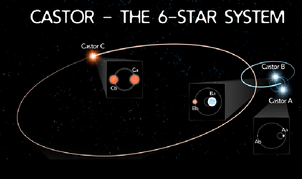
Castor is a sextuple star system made of three
binaries, bright visual stars Castor Aab and
Bab and dim red flare stars YY Geminorum AB,
which are much brighter in X-ray wavelengths.
The System is claimed by the United Stars of the Galaxy . While it was within Freon space, the Freons never utilized or occupied the system.
The Six suns are
- Castor Aa
- Castor Ab
- Castor Ba
- Castor Bb
- Castor Ca (YY Geminorum Aa)
- Castor Cb (YY Geminorum Ab)
System has four planets and extensive Asteroid fields. System has a traffic hub (Castor Hub) with Space Tram connection to Capella for trans galactic Space Train access.
System is represented. 44 Billion Union residents.
System Summary
The distance of Castor, or Alpha Geminorum, from Sol was estimated by the HIPPARCOS mission to be about 51.6 light-years (ly) using a space-based parallax (Plx=0.06327, e_Plx= +/- 0.00123). On the other hand, the Yale Parallax Catalogue suggests a distance of 43.7 ly. However, it has about twice the acknowledged error based on an average of Earth-based observations. Given the past difficulty of obtaining good Earth-based parallaxes noted in the literature and for the sake of simplicity, most new calculations presented here will use the farther HIPPARCOS distance estimate.
In 1998, Castor was confirmed to be the title member of the Castor Moving Group of 16 stars (which includes Vega and Fomalhaut) whose stellar characteristics suggest a young average age of around 200 (+/- 100) million years (D. Barrado y Navascues, 1998; and Anosova and Orlov, 1991). Since its birth, the Castor system has moved away from its original cluster stars and into into the vicinity of Pollux. Although is Pollux actually the brightest star of Constellation Gemini (color photo), the Twins, Johannes Bayer (1572-1625) gave the first-rank Greek letter designation of Alpha to Castor (7:34:35.9+31:53:17.8, ICRS 2000.0) around 1600. Hence, it has been suggested that one of these stars may have changed in luminosity during the past four centuries. Indeed, Castor (the "Horseman" of the two warriors) is not much like its "twin" star Pollux. (See Akira Fujii's color photo of Castor -- blue star at the top left of photo.)
While Pollux is a highly evolved and relatively cool orange-red giant, single star, Castor is actually composed of three sets of tight, spectroscopic binary stars with a combined luminosity of 52.4 times that of Sol's. The Castor system has as many as four bluish-white, main sequence stars and two known, fainter red dwarf companions. The outer pair (YY Gem) was separated from the inner quadruple of bright stars by over 1,100 AUs (73" at a HIPPARCOS distance estimate of 51.6), moving in an orbit that may take some 10,000 years to complete; with a 40 percent probability of being quasi-elliptical and a 60 percent probability of being hyperbolic (Anosova and Orlov, 1991). According to Robert Burnham, Jr. (1931-93), the star's multiplicity was probably first resolved in 1678 by Giovanni Domenico Cassini (1625-1712) as the first gravitationally bound objects observed beyond the Solar System. (See an animation of the planetary and potentially habitable zone orbits of the Castor AabBab system and of the Cab system, each with a table of basic orbital and physical characteristics.)